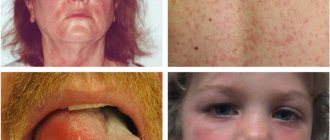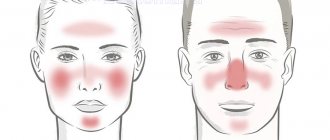Hello dear readers of my blog!
Today I want to tell you about lupus erythematosus (synonym: erythematosis), or more precisely about its cutaneous form - discoid lupus erythematosus.
Before we talk about it, first we’ll talk briefly about lupus in general.
Systemic lupus erythematosus is a serious disease that affects connective tissue and blood vessels. Its manifestations include fever (in 90% of patients), skin lesions (in 85%), damage to the joints, kidneys, heart and lungs. Rheumatologists treat this disease.
With systemic lupus erythematosus, rashes characteristic of discoid (cutaneous) lupus erythematosus occur.
However, discoid lupus erythematosus itself does not always develop into systemic lupus.
Considering that both systemic and cutaneous lupus erythematosus manifests itself on the skin, very often patients with these forms turn to a dermatologist for the first time.
Cutaneous manifestations of lupus are often divided into three types.
The first is subacute cutaneous lupus erythematosus
. I will not dwell on this form in detail, I just want to say that it often resembles psoriasis, so it is easy to confuse it with it.
The following two types are classified as the chronic form of the disease.
This is deep lupus erythematosus (Kaposi-Irganta)
, which is rare and manifests itself as dense subcutaneous painful nodes on the face, scalp, mammary glands, shoulders, thighs and buttocks.
And finally, discoid lupus erythematosus
, which I want to talk about today.
Why is it interesting from the point of view of skin diseases? And the fact that in the initial stage it is very difficult to distinguish it from ordinary irritation on the face, rosacea (see article on rosacea here) and other skin diseases.
Discoid lupus erythematosus
Rosacea
Even at the beginning of the disease, if we perform a biopsy - take a piece of skin for analysis (histology), this may not yield anything, there will simply be a picture of inflammation.
And so, discoid lupus erythematosus is the most common form of all lupus erythematosus - 88% of all forms.
The disease can occur at any age, but quite often begins between 20 and 40 years, women are more often affected (4:1). It is most common in countries with wet and cold climates and is rare in the tropics.
Lupus erythematosus is an autoimmune disease with a genetic predisposition that occurs without any apparent reason, and its appearance can also be triggered by viruses, prolonged exposure to insolation or hypothermia, stress, bacteria, certain medications and other factors.
Thus, as I already wrote in the article “On the causes of skin diseases,” since the disease is based on human genetics, then, unfortunately, there are no radical treatments for lupus erythematosus. The goal of treatment is to eliminate the clinical manifestations of the disease, limit their spread, minimize scarring and further prevent relapses!
The size of lupus erythematosus lesions varies (diameter 0.5 – 5 cm or more).
The number of lesions varies from one to many. Discoid lupus erythematosus has a typical localization: the skin of the malar region, nose and cheeks, ears, neck, and sometimes chest.
The scalp may be affected,
red border of the lips (“lupus cheilitis”) and oral mucosa.
With discoid lupus erythematosus, three stages are distinguished: erythematous, follicular hyperketatosis and atrophy stage.
Erythematous
The lupus erythematosus stage begins with the appearance (usually on the face) of a pinkish-red, swollen spot or spots.
The spots gradually increase in size, become denser and become covered with small grayish scales, firmly seated at the mouths of the hair follicles. This is already the stage of follicular hyperkeratosis
.
An attempt to remove scales from the surface of the plaque is accompanied by pain (Besnier-Meshchersky symptom). When you remove the scales from their reverse side, you can see horny spines (a symptom of “ladies' heels”).
The area of the lesions increases, and new lesions of the same type appear. Along the periphery of the lesion, infiltration, keratinization, redness, and swelling intensify.
During the transition to atrophic
stage, cicatricial atrophy forms in the center of the plaque, the skin becomes thinner and easily folds. Sometimes telangiectasia (spider veins) appear in areas of atrophy.
Subjective sensations are usually absent. Very rarely, patients are bothered by minor itching or burning.
In the discoid form of lupus erythematosus, transformation into systemic lupus occurs rarely - in 1-7% of patients.
The cutaneous form of lupus erythematosus is characterized by a long continuous course with periodic deterioration in the spring and summer due to excessive insolation.
Diagnosis of lupus erythematosus
The diagnosis of lupus erythematosus is based on the clinical picture, histological and immunohistochemical studies.
As I said earlier, at the erythematous stage, lupus erythematosus is very difficult to distinguish from rosacea, seborrheic eczema. Even histological examination may yield nothing.
Patients require careful follow-up and monitoring of laboratory data, because with a long course, sometimes a visceral and/or laboratory picture is formed, indicating the transformation of the cutaneous form into a systemic one.
“Unknown” lupus - answering questions
The article was prepared by rheumatologist Daria Aleksandrovna Pogonchenkova
The TV series “House” told people far from the medical world about systemic lupus erythematosus (SLE). Of course, this does not make the phenomenon of the disease any clearer: there is no accurate information about what exactly causes the disease and how lupus will manifest itself.
Below are the most frequently asked questions about systemic lupus erythematosus and their answers.
- What is SLE and how does it manifest?
The onset of lupus (or any other autoimmune disease) is extremely difficult to explain or predict. The term "autoimmunity" means that at one point, out of the blue, cells in your immune system begin to attack the body.
Such an idiopathic process can be caused by genetic changes, heredity, hormonal surges, increased levels of insolation (exposure to sunlight), or maybe absolutely nothing. Why is the disease called systemic, red, and, in fact, lupus?
The name “lupus erythematosus” was not assigned to the disease by chance. One of the identifying signs of the disease (which, by the way, does not appear in every lupus scenario) is a red rash on the face that resembles wolf bites. “Systemic” means that the disease does not occur in isolation, but affects several body systems at once. The “favorite” targets of lupus are the lungs, kidneys, heart and central nervous system.
Lupus can manifest itself in completely different ways, and that is why it is nicknamed the disease with a thousand faces: it shows itself through local symptoms of lesions, having practically no symptoms of its own.
Common symptoms of SLE:
- discoid rash, worsens after contact with the sun;
- arthritis of small joints with swelling of the hands and feet;
- pain in joints, muscles, atypical pain in the lungs, migraines
- depressed mood;
- nausea, vomiting;
- stomach upset.
Of course, a professional doctor and modern diagnostic methods make it possible to connect the symptoms together, make the correct diagnosis and begin timely treatment.
- Who is the main risk group?
The main risk group is young women of reproductive age, from 18 to 35 years old. The exact connection between female sex hormones and the onset of the disease has not been established, however, we can talk about immunological hyperreactivity due to “peaking” estrogens.
- What and how is SLE treated? Is it possible to be completely cured?
Unfortunately, there is currently no complete cure for lupus. On the other hand, timely diagnosis and appropriate treatment can guarantee long-term remission, which is an excellent result for an unpredictable autoimmune disease.
Treatment of SLE is multi-stage, combined and not at all easy. In addition to symptomatic and local medications, patients are prescribed glucocorticosteroids, initially in high doses, gradually decreasing towards remission (necessary to suppress aggressive immune reactions), TNF cytokine blockers, and non-steroidal anti-inflammatory drugs.
Long-term (and in some cases short-term) sun exposure is contraindicated for patients with systemic lupus erythematosus.
Incorrectly selected or untimely treatment can lead to the development of a wide range of dangerous complications, depending on the location and extent of the lesion.
- Are there any external manifestations?
Although it is impossible to recognize lupus at first glance, there are two signs that are the hallmark of the disease: the “lupus butterfly” and the discoid rash.
“Lupus butterfly” is a small rash on the face, symmetrically located on the cheeks on either side of the nose. It somewhat resembles the wings of a butterfly, which is why it got its name.
Discoid rash is a large focal rash that affects any area of the skin (characteristic of discoid lupus erythematosus). It worsens under direct sunlight - in some severe forms (subacute cutaneous), ulcers may form at the site of the discoid rash.
Of course, systemic lupus erythematosus is an extremely terrible and insufficiently studied disease, but modern doctors do not stop there and are developing more and more new ways to get rid of the disease and control it. For more than a year, our center has been conducting clinical trials of a new drug for the treatment of SLE. The goal is to reduce the number of exacerbations and gradually reduce the dose of hormonal drugs to the minimum for each patient. After a year of treatment, the patient has access to a new drug and observation for another 2 years.
MAKE AN APPOINTMENT WITH A RHEUMATOLOGIST
Blood test for lupus erythematosus
Once a year, a blood test is recommended for: liver parameters, C-reactive protein, antinuclear antibodies (detected in 20% of cases), SS-A (anti-Ro) and SS-B (anti-La) antibodies (in 3% of cases) , antiphospholipid antibodies, anti-DNA and antinuclear factor antibodies, anti-smooth muscle antibodies (less than 5%) usually indicate systemic lupus erythematosus. Also with discoid lupus erythematosus, the following are possible: cytopenia (deficiency of one or more different types of blood cells), increased ESR, positive rheumatoid factor, proteinuria (the presence of protein in the urine).
Important! Only a doctor, and not the patient himself, can make a diagnosis of lupus erythematosus and distinguish it from other diseases! And only a doctor should monitor the dynamics, and in person!
Systemic lupus erythematosus - symptoms and treatment
The goals in the treatment of SLE are to reduce the severity of the disease, prevent exacerbation and induce remission of the disease. It is important for the patient to maintain his physical, mental, social and emotional functions at the same level [8]. During treatment, they strive to achieve clinical and laboratory remission, in which the patient feels well, blood and urine tests are normal, and to prevent damage primarily to the kidneys and central nervous system, as well as other body systems.
It is impossible to influence the cause of SLE, so therapy is used that prevents the development of the disease, that is, it prevents the formation of immune complexes.
Groups of drugs used in the treatment of SLE:
Glucocorticoids (GCs) are first-line drugs for SLE. Glucocorticoids are normally produced in the adrenal glands and prevent inflammatory processes. For treatment, synthetic forms are used in the form of tablets, skin cream or injections [8]. The most effective short-acting drugs are those that minimally affect mineral metabolism:
- prednisolone;
- methylprednisolone (Urbazon, Medrol, Solu-Medrol).
They are used mainly in tablets and only in extreme cases intramuscularly, increasing the dose by 3-4 times compared to tablets. The dosage depends on the activity of the disease:
- low activity < 10-20 mg/day;
- moderate - 20-40 mg/day for 2-4 weeks with a gradual reduction to maintenance doses;
- high activity > 1 mg/kg/day (but not more than 60 mg/day), duration depends on the clinical effect.
If you stop taking GC, the disease may worsen and higher doses of hormones along with cytostatics will be required, which can cause irreversible changes in many organs. Therefore, even when the patient is in remission, doctors prescribe constant use of low doses of GC (1-1.5 tablets of prednisolone or methylprednisolone). It is impossible to abruptly stop taking GC or reduce the dose.
Side effects of GC:
- uneven development of adipose tissue (a rounded face resembling the shape of the moon, deposition of fat in the abdomen and back in the form of a “hump”);
- increased appetite and obesity;
- emotional imbalance;
- stretch marks (purple stretch marks on the skin);
- increased hair growth;
- increased blood pressure;
- high cholesterol and glucose levels;
- early development of atherosclerosis and cataracts;
- development of osteoporosis, leading to bone fractures.
To reduce the risk of side effects during GC therapy, it is necessary to take calcium and vitamin D supplements, monitor sugar, cholesterol and blood pressure levels. You should normalize your weight and give up tobacco. Physical exercise will help reduce the negative effects of GCs on the cardiovascular system [8][13][14].
Also, when taking GC, the volume of the adrenal glands decreases, because the drugs reduce the production of their own hormones. That is why abrupt discontinuation of GC is unacceptable - this can lead to the development of acute vascular crises. To get the adrenal glands used to producing their hormones, the dose of GC is reduced very slowly over weeks and sometimes months [7][8].
Cytostatics. Patients with SLE with a high degree of activity (involvement of the kidneys or central nervous system, damage to many organs and systems) are prescribed cytostatics (immunosuppressants). These include:
- cyclophosphamide;
- azathioprine;
- mycophenolate mofetil;
- methotrexate.
Cytostatics suppress the activity of the immune system by regulating the production of immune cells. These medications must be taken for a long time (up to several years) under the control of blood tests, urine tests, liver tests and under close medical supervision due to the risk of side effects (nausea, vomiting, hair loss, cystitis, increased risk of cancer and infections) [7] [eleven].
NSAIDs (non-steroidal anti-inflammatory drugs) are prescribed for fever and to relieve joint and muscle pain. NSAIDs include:
- "Nise";
- "Nimesil";
- "Arcoxia" and others.
Antimalarial drugs. Used for mild forms of SLE. Initially used to treat malaria. Such drugs include hydroxychloroquine - an auxiliary, and sometimes the main method for the benign course of SLE. Use 200 mg per day, the dose can be increased to 400 mg per day. Improvement appears after 4-6 months.
SLE patients need to reduce lipid and sugar levels and reduce the risk of blood clots.
Once a year, a complete ophthalmological examination , as retinopathy (photophobia and color vision disturbances) may develop.
Extracorporeal methods of treatment.
Plasmapheresis is used in severe cases with rapidly progressing renal failure and damage to the central nervous system and lungs. This is a procedure for taking blood, clearing it of immune complexes and returning it or some part back into the bloodstream.
Genetically engineered biological drugs (GEBPs) - rituximab and belimumab.
Excessive production of autoantibodies is a major factor in the inflammatory process and organ damage in SLE. Autoantibodies are produced by special cells - B-lymphocytes (B-cells), so if their activity is suppressed, it is possible to solve one of the important problems of SLE therapy.
The main anti-B cell drugs are rituximab (Abthera) and belimumab (Benlysta), which reduce the number of B lymphocytes and reduce their activity, thereby promoting remission of the disease. In addition, it is possible to reduce the dose of GC and cytostatics.
Rituximab is prescribed for severe disease - for kidney damage that is resistant to other therapy. Rituximab reduces the activity of the disease, the drug affects skin syndrome, central nervous system damage, and arthritis. It is prescribed as a dropper and administered slowly over 60 minutes.
Belimumab (Benlysta) is the first DMARD specifically designed for the treatment of SLE in patients refractory to standard treatments. A contraindication to the use of belimumab is severe damage to the kidneys and central nervous system. The drug is administered intravenously in a hospital using a dropper over one hour.
Rituximab and belimumab rarely cause side effects. These are mainly allergic reactions in the form of a rash on the skin, sore throat, difficulty breathing, swelling of the face and lips. In this case, the medications are discontinued and antihistamines and GCs are administered [11][12].
All patients with SLE are subject to dispensary observation. This is necessary in order to:
- recognize a beginning exacerbation in time;
- identify side effects and complications of drug therapy.
It is important to explain the need to follow the recommendations and the inadmissibility of stopping treatment on your own, as this is dangerous for the patient.
A patient with SLE must:
- Visit a rheumatologist at least twice every three months.
- Get tested every three months:
- general blood analysis;
- Analysis of urine;
- blood chemistry.
- Annually:
- take a lipid profile test to prevent atherosclerosis;
- undergo densitometry (diagnosis of bone density and likelihood of fractures) to prevent osteoporosis;
- do Rg-graphy of the pelvic bones to avoid aseptic necrosis of the femoral head;
- have an ophthalmological examination to prevent the risk of retinopathy when taking hydroxychloroquine;
- determine titers of antibodies to phospholipids (in the presence of secondary antiphospholipid syndrome);
- visit a gynecologist.










